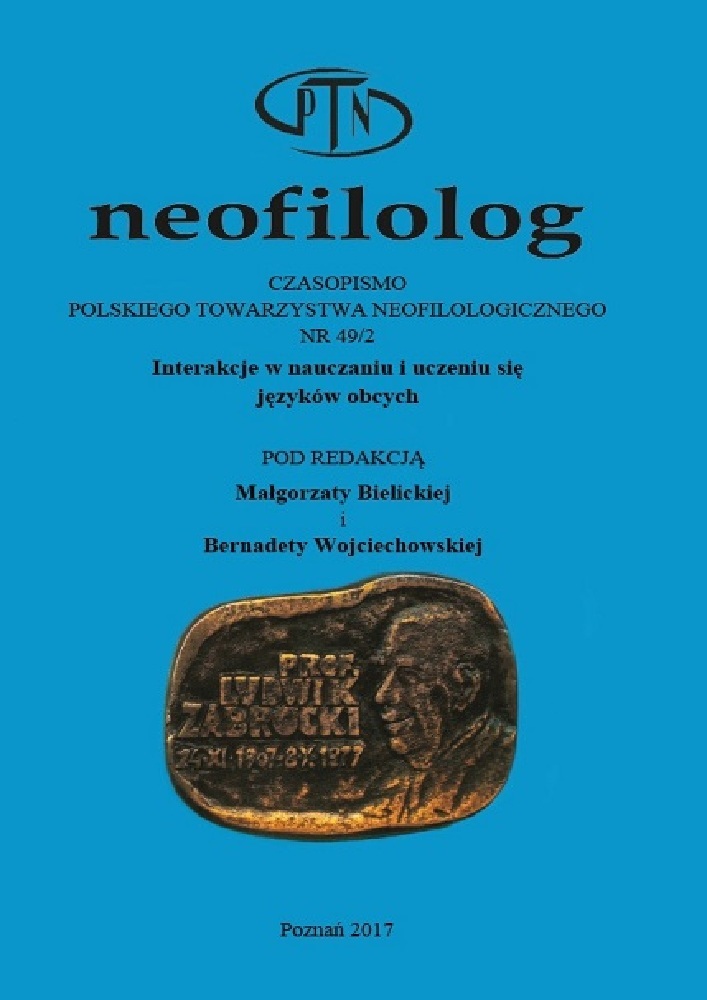Abstract
Foreign language classes at university should enhance not only knowledge of foreign languages but with the use of different methods, should also develop skills of communication strategies, which are very important to compensate for deficits in communication. These strategies are indispensable for language learners irrespective of their level of proficiency. The objective of the study described in the present paper is to explore the communication strategies used by Polish students at different levels of knowledge of Italian. Data was collected by two types of questionnaires, one including two open-ended questions. The other was based on a Likert-scale method which examined the frequency of usage of avoidance strategies, verbal and non verbal strategies, as well as the strategy of transfer. Emphasis was placed on the relationship between the use of types of communication strategies and students’ level of proficiency. In the final part the author recommends types of lexical exercises which should be practised during classes to help students to develop their communicative skills.References
Canale, M. i M. Swain. 1980. „Theoretical bases of communicative approaches to second language teaching and testing”. Applied Linguistics 1: 1-47.
Corder, P. S. 1982. Error Analysis and Interlanguage. Oxford: Oxford University Press.
Jakobson, R. 1989. W poszukiwaniu istoty języka. Wybór pism, t. 1. Warszawa: PIW.
Morytz, J. 2017. „Nauczanie kreatywności podczas lektoratów języka ekonomicznego”(w druku).
Pawlak, M. 2014. „Strategie komunikacyjne w nauce języka obcego – próba integracji perspektyw”. Konińskie Studia Językowe 2 (1): 11-33.
Piotrowski, S. 2013. „O strategiach w komunikacji egzolingwalnej w warunkach formalnych”. Lingwistyka Stosowana 8: 117-131.
Piotrowski, S. 2016. „Strategie komunikacyjne, czyli jak uczący się radzą sobie z deficytami leksykalnymi w klasie języka obcego”. Języki Obce w Szkole 1: 26-31.
Porquier, R. 1979. „Stratégies de communication en langue non-maternelle”. Travaux du Centre de Recherches Sémiologiques de Neuchâtel 33: 38-52.
Rada Europy. 2003. Europejski system opisu kształcenia językowego: uczenie się, nauczanie, ocenianie. Warszawa: Wydawnictwa CODN.
Selinker, L. 1972. „Interlanguage”. International Review of Applied Linguistics 10: 209-231.
Tarone, E. 1977. „Conscious communication strategies in interlanguage”. (w) On TESOL’77: Teaching and Learning English as a second Language. (red. H. Brown, C. Yorio i R. Crymes). Washington, DC: TESOL, str. 194-203.
Wilczyńska, W. 1999. Uczyć się czy być nauczanym? O autonomii w przyswajaniu języka obcego. Warszawa–Poznań: Wydawnictwo Naukowe PWN.
License
Copyright (c) 2017 Jolanta Morytz

This work is licensed under a Creative Commons Attribution-NoDerivatives 4.0 International License.
Authors
Authors of texts accepted for publication in Neofilolog are required to complete, sign and return to the Editorial team’s office the Agreement for granting a royalty-free license to works with a commitment to grant a CC sub-license.
Under the agreement, the authors of the texts published in Neofilolog grant Adam Mickiewicz University in Poznań a non-exclusive, royalty-free license and authorize the use of Attribution-NoDerivatives 4.0 International (CC BY-ND 4.0) Creative Commons sub-license.
The authors retain the right to the free disposal of the work.
Users
Interested Internet users are entitled to use works that have been published in Neofilolog since 2017, under the following conditions:
▪ attribution – obligation to provide, together with the distributed work, information about the authorship, title, source (link to the original work, DOI) and the license itself.
▪ no derivatives – the work must be preserved in its original form. Without the author's consent, it is not possible to distribute the modified work in the form of translations, publications, etc.
Copyrights are reserved for all texts published since 2017.
Miscellaneous
Adam Mickiewicz University in Poznań retains the property right as a whole (layout, graphic form, title, cover design, logo etc.).
